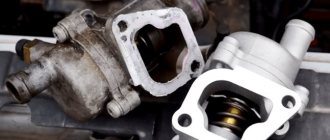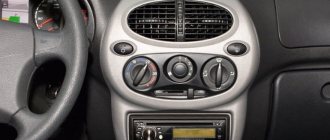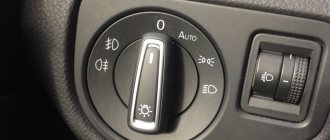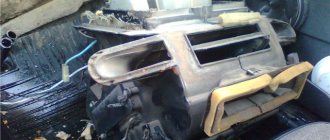Replacing the VAZ 2107 heater motor.
Hello.
Over time, the grease in the bushings of the heater motor dries out, which causes creaking, whistling or howling. Or the stove stops blowing altogether because the windings of the stove motor are burned out. In these cases, the VAZ 2107 heater motor is replaced and how to do this, read on. I do not recommend lubricating the bushings of the heater motor because... The effect will not last long, and the procedure for removing the motor is quite lengthy. It is better to replace it immediately, so as not to climb into the same place twice. How to understand that it is the heater motor that is not working, and not a broken switch button or a blown fuse, read the article “The VAZ 2107 heater fan does not work”
Examination
To make sure that the motor is the cause of the heating system malfunction, you should carry out a simple but indicative procedure:
- Start the car;
- Turn on the first, second and third speeds of the stove alternately;
- If there are no sounds indicating the start of the fan operation, the motor has failed;
- If the fan did not turn on at speeds 1 and 2, but started working at speed 3, then the cause of the problem may be a switch or an additional resistor.
Causes of failure
The motor may not work for several reasons. Each of them requires separate consideration. Therefore, we invite you to familiarize yourself with the possible causes of fan failure in our table.
Depending on the problems encountered, you may need to replace the fan. Changing the motor is not difficult, although to do this you must have some skill or at least minimal experience in working with the electrical equipment of your car.
The first step when replacing the heater motor is to disconnect the battery.
Motor location
How to remove the VAZ 2107 heater fan.
And so, let's start by removing the radio, if you have one. The next step is to remove the beard. Sequence of actions to remove it:
- We unscrew the 4 screws of the shelf, which is located at the feet on the passenger side.
- Remove the panel with the clock and cigarette lighter.
- Unscrew the two 10mm nuts.
- Unscrew the two screws screwed into the tunnel.
- We disconnect the pads from the buttons and the beard is removed.
Let me show you photos of where and what needs to be unscrewed.
Unscrew the four screws securing the shelf.
We remove the panel with the clock and the cigarette lighter by prying it with a flat screwdriver on both sides and pulling it out towards you.
Unhook all the wires from the clock panel and unscrew the two 10mm nuts.
Now at the bottom, where the buttons are located, on the side facing the rear passengers there is a plastic plug. We unscrew it with a flat screwdriver and see two screws. We unscrew them.
We disconnect the wires from the buttons and move the beard to the side, now nothing is holding it.
Here you can see the heater fan housing. To get it, you must first disconnect the side air ducts.
The stove motor is located in the lower part of the housing. To get it out, use a flat screwdriver to carefully remove the four iron brackets. Be careful when removing brackets ! They can fly away and get lost!
After removing the brackets, the stove body is simply pulled out.
The wires going to the heater motor will prevent us from completely pulling out the housing. We disconnect them.
The motor is attached to the body with two iron brackets, snap them off and you're done! You can replace the VAZ 2107 stove fan.
Now about the setup itself
Maintaining the required fuel level in this device is ensured by a float mechanism.
Setting the float mechanism
- Start the car engine and let it idle for 2-3 minutes;
- Remove the carburetor cover;
- Check the fuel level in the float chamber. It should be 28 mm.
In case of deviation, we perform the following actions:
- Measure and adjust the distance between the cover gasket and the float when the float tongue touches the needle valve ball. It should be 6.5±0.25 mm. Adjust by bending the tongue;
- Check the maximum valve needle travel. It should be 8 mm. To check, it is necessary to measure the distance between the cover gasket and the maximum retracted float. It should be 14±0.5 mm. The deviation is eliminated by acting on the bracket;
- Visually check that the tongue of the needle valve axis is perpendicular and that the float is parallel to the bottom plane of the cover. If there are any violations, correct them.
If all of the above steps fail to achieve a stable fuel level (28 mm) in the float chamber, then the needle valve must be replaced.
Adjusting the starting device of the VAZ 2105 carburetor
- Using the thrust handle located in the cabin, close the air damper;
- Check that the rod shank is at the end of the carburetor trigger rod groove. If there is a violation, correct it by bending the rod;
- Remove the cover and measure the gap between the edge of the air damper and the chamber wall with the starter rod recessed (we recess the rod using a screwdriver with the rod disconnected). It should be 5.0-5.5 mm. We adjust by rotating the adjusting screw of the starting device.
Idle adjustment
This type of work should be carried out on a warm engine.
- Use the mixture quantity screw to bring the engine to 850 rpm;
- Use the quality screw to bring the speed to the maximum level;
- Use the quantity screw to reduce the speed to 850;
- Use the quality screw to bring it to maximum again;
- Having thus achieved 850 rpm, tighten the quality screw until the engine “shakes”;
- By unscrewing the quality screw, achieve stable engine operation.
With proper adjustment of the VAZ 2105 carburetor, fuel consumption in the summer should not exceed:
- outside the city on the highway at a speed of 90 km/h – 7 – 7.5 liters per 100 km;
- during the urban driving cycle - 8.5 - 9 liters.
If you cannot do this work on your own, it is better not to torture yourself and the car, but contact the AvtoVAZ service center.
The VAZ 2107 carburetor, also known as “Ozone”, gained the greatest popularity among competitors “Weber”, “Solex” and “DAAZ”, specifically for this Lada model. Less popular is the DAAZ prototype.
The circuit of each of them is basically the same, but each has a special device. In order to determine which sample is best to put on the “Seven”, let’s look at each sample separately.
How to install the heater motor in a VAZ 2107.
If you are faced with a choice: install a cheap one with bushings or a more expensive one with bearings - choose a better motor with bearings, it is a little quieter than a bushing motor and will last much longer.
Before installing a new motor, make sure that there is grease in the bushings or bearings; if there is no or little grease, then the bushings are lubricated with silicone grease, and the bearings with ordinary lithol.
Replacement and assembly are carried out in reverse assembly order.
That's all! If you have any questions, ask them in the comments.
Replacing the VAZ 2105 heater yourself
Many owners of the Five have tried and are trying to improve the heating system of their car. And not always only a complete replacement of the VAZ 2105 heater is the only correct solution. Often on a VAZ 2105, replacing the heater valve or other modifications is of great benefit. For example, you can independently seal the joints of the air exhaust hoses or redistribute the air flows, but still, this does not provide much efficiency.
Replacing the heater valve VAZ 2105
Heater valve VAZ 2105
Replacing the heater tap with a VAZ 2105 and other improvements are aimed only at maximizing the operation of the stove. As mentioned above, this replacement is carried out due to the improvement and modernization of the operation of the stove (a ceramic version can be installed) or if the old tap begins to leak. A leaking faucet can cause a lot of trouble for a car owner. Therefore, eliminating the leak will be the only correct solution, and this can only be done by replacing the tap.
Advice. We purchase a heater stove faucet in a store, preferably with two pipes. It is worth noting that the choice of cranes today is huge. Still, experts and experienced drivers advise buying a ceramic faucet. It has better equipment than the regular one. There are a lot of details in it.
- Rubber rings.
- Fastening nuts.
- Washers.
- Aluminium case.
- Ceramic filling and much more.
Ceramic faucets last much longer than regular metal ones. They practically do not stick like regular ones. We begin the replacement, armed with a jack, spanners and wrenches, sockets and an extension cord. We lift the car onto the inspection hole, which will greatly facilitate the work process. Let's get started:
- take some container and place it under the engine;
- unscrew the plug on the block and then drain the coolant;
- after this we remove the container, but not far, since it will still be needed;
- we find the pipes that go from the engine to the heater tap;
Pipes going from the engine to the tap
- loosen the pipe clamps;
- take a metal brush and clean the threaded connections of the two studs.
Advice. To avoid problems with loosening the nuts, it is recommended to moisten the connections with brake fluid. After all, studs are not ordinary bolts, but parts whose heads are buried in the plastic body of the faucet. The fastening nuts on the caps are self-locking and have plastic rings that are difficult to unscrew. Well, if you add corrosion to this, then everything becomes clear.
- remove the pipes while the threaded connections are acidifying (remember that you need to place a container under the pipes, since liquid flows from there);
- go to the salon;
- remove the side panel of the torpedo;
- then we find the pipe clamps;
- take a socket wrench with a cardan and unscrew the clamps;
- remove the pipes and replace them with new ones;
- after removing all the pipes, we climb under the car again;
- we find the nuts securing the heater valve;
- use a 10mm wrench to unscrew them;
- we return to the salon;
- pull the tap towards you;
- remove the spring clip;
- disconnect the control cable from the crane;
- install a new heater tap, first connecting the cable and attaching the tap to the body.
That's all! A new heater valve has been installed. The rest of the assembly is carried out in reverse order.
Assembly
Assembling the VAZ 2107 heater occurs in the reverse order. First, we screw the pipes to the radiator and thread the part into the hole between the body and the engine. We put on the loop of the stove control cable and install the diaphragm. We connect the pipes, and be sure to tighten their edges with clamps.
When repairing or replacing this mechanism, it is recommended to replace all gaskets in order to increase their service life. The final step is to reinstall the radio panel and assemble the glove compartment. Replacement of the VAZ 2107 radiator is completed. Now, start the engine, warm it up for 5-10 minutes, and turn on the heater. First, do not forget to open the faucet, which is located under the dashboard, on the passenger side. If warm air is blowing from the vents, then the problem is solved, but if not, then it is better to contact a specialist.
Sources
- https://miravto24.ru/zamena-radiatora-pechki-vaz-2107/
- https://vazkorch.ru/stati/zamena-radiatora-pechki-na-vaz-2105-2106-2107.html
- https://vashalada.ru/mashiny/vaz-2107/zamena-radiatora-pechki-vaz-2107-video-instrukciya.html
Radiator and heater fan
You should know that in order to always keep the interior of a five-wheeler warm and cozy, especially on winter days, you need to be able to increase the amount of heat supplied. Which part is directly responsible for supplying warm air? Of course, the radiator. But there is a problem - at the top five the fan is so loud that it makes you laugh. It is very small and simply not capable of creating the required flow. What to do? First, let's compare the fans on the VAZ 2105 and the VAZ 2108. The first motor consumes 4.5 A current and has a rotation speed of 3000 rpm, and the second one 14 A, but spins 4100 rpm. This already says something. It is recommended to replace the fan with another one.
Replacing the heater fan VAZ 2105
Replacing the heater fan on a VAZ 2105 is carried out as follows:
- the lower part of the stove is removed (this is a simple casing, on top of which a regular electric fan is installed);
- the old fan is removed;
- we cut off one of the aerodynamic ridges that supply air to the legs of the driver and passenger (this is done due to the fact that the fan motor of the VAZ 2108 is much longer);
- the impeller is also removed, which will not allow the fan from the VAZ 2108 to sit in place;
- Instead, a homemade one is installed.
Advice. In order not to remove the impeller, but to leave everything as is, you can use another fan. A standard five-bladed fan for classics, which has a motor several times more powerful, is suitable. And its weight is much lighter, and the rotor of the new motor rotates stronger than even that of the VAZ 2108.
- increase the diameter of the impeller hole;
- we insert a new shaft there (we do this very carefully so as not to break the impeller);
- connect the fan and check its operation;
- adjust the resistor and assemble everything in reverse order.
Heater VAZ 2105 fan replacement
Advice. It is recommended to replace the resistor on the five by installing the eight version. The new resistor must ensure quiet operation of the fan. The fan switch should also be replaced.
Control mechanism
The control of the VAZ 2107 stove is mechanical. It consists of a fan switch and a block of sliders. The control mechanism is installed on the center console at the top, which provides easy access to the elements.
There are three sliders of the control mechanism, and each of them controls its own element:
- The top one is responsible for supplying antifreeze to the radiator and is connected by a cable to a tap installed on the inlet pipe. The extreme left position of the slider means the tap is closed (the stove does not heat), the right position means the tap is open (antifreeze enters the radiator).
- Middle – air supply damper control. When you move it to the left, the damper shuts off the air supply from the street (closed air circulation in the cabin), while the right position means the air flow is open (air from the street enters the cabin).
- The lower one controls the damper for distributing the flow through the air ducts. Left position - the flow is supplied through the side and central deflectors, right - to the windshield area. Each of these sliders can be adjusted to any position to achieve optimal stove operation.
Replacing the heater VAZ 2105
Replacing the heater VAZ 2105
What does the stove consist of?
Before you start replacing, it is useful to familiarize yourself with the design of the VAZ 2105 stove. It consists of:
- control lever bracket;
- internal ventilation air ducts;
- special control lever handles;
- air ducts for heating side windows;
- from flexible rods;
- from a clamp;
- rubber hoses;
- tap;
- pipe seal;
- air duct damper;
- air distribution cover.
Removal and installation
If you decide to completely replace the stove, then this is done as follows:
- the ground wire is disconnected from the battery;
- the instrument panel and receiver panel are removed;
- the heater valve control lever is moved all the way to the right;
- Coolant is drained from the heating system;
- the clamps are loosened;
- the rubber hoses are disconnected from the heater pipes (they control the supply and removal of fluid);
- the seal is removed (it is recommended to watch a detailed video before removing);
- two bolts securing the bracket are turned out (they are located inside the engine compartments);
- the bolts of the fastening brackets are loosened;
- the rods are disconnected and the bracket is removed;
- the nozzles are removed on the left and right;
- nut fixing the right air duct for heating the side windows;
- the left air duct is removed in the same way;
- we find four spring-type holders and remove them;
- remove the heater fan casing assembly;
- loosen the radiator casing nuts;
- the ground wire is disconnected and the casing is removed;
- the air duct is removed;
- the old heater is removed;
- The new heater is installed in the reverse order (photo below).
New heater for VAZ 2105
Advice. When installing the heater, pay attention to the installation of the sealing gasket. It is located between the car body and the radiator casing. Also, the heater control should be adjusted during installation.
You can do a lot with your own hands in a way that no specialist can do. The step-by-step instructions given above will help novice motorists do everything on their own. In addition, you can save a lot of money, because the price for these services is high today.
Thermostat repair
And if it comes to complete disassembly, then you should take into account that the antifreeze will begin to pour out. To prevent leakage, we close the pipe in every possible way and disassemble it. After repairing the thermostat, it is still strongly recommended to replace it as soon as possible.
After repairing the thermostat, it is still strongly recommended to replace it as soon as possible.
- Inlet pipe (from the radiator).
- Rubber insert.
- Solid heat-sensitive filler.
- Bypass valve spring.
- Inlet pipe (from the engine).
- Bypass valve.
- Outlet pipe (to the pump).
- Main valve spring.
- Main valve.
- Branch pipe (from the expansion tank).
- Piston.
Recently the thermostat on my VAZ 2114 swallow failed. There were no chisel thermostats in the store, but the seller said: “This one will do!” and put a thermostat from a VAZ 2111 on the table.
- The thermostat itself.
- Tee with an outer diameter of “19”.
- A hose 40-60cm long from the Moskvich 2141 stove.
- A couple of clamps.
- Take the "8" key and unscrew the screws securing the air filter.
- Take a screwdriver and loosen the clamps of the crankcase cooling system and the throttle pipe air duct.
- Unscrew the screw of the throttle valve cable bracket.
- Disconnect the electrical connector.
- We remove the rubber cushion of the filter housing from the hole in the bracket and remove the air filter.
- Using a 13mm wrench, unscrew the bolt securing it to the clutch housing and the bolt securing it to the block.
- We only loosen the lower fastening bolt with a 17 key, since the hole in the bracket is made in the form of a fork.
- move the module to the side.
- Using the “13” key, unscrew the plug on the block.
- Unscrew the radiator drain plug by hand.
- pour the “Antifreeze” into the prepared container.
- loosen the four clamps of the thermostat pipes.
- remove the thermostat.
- disconnect the connector.
- Use a 19mm key to unscrew the temperature sensor.
- Using a 13mm wrench, unscrew the nut securing the ground wire of the controller.
- unscrew two more nuts.
- remove the pipe block.
Such a replacement is quite possible on a carburetor engine. In this case, the hole for the temperature sensor in the new thermostat must be securely plugged.
mooncat › Blog › Replacing the heater valve and heater fan VAZ-2104/2107
Over the past months, quite a lot of manipulations have been carried out with the car; there was no time to sit down and write. Now I’ve decided that I need to start airborne at some point.
You probably can’t be called a full-fledged owner of a Lada if you haven’t changed the heater faucet and fan :))))
At the time of buying the car, it was scary to turn the heater fan on to second speed - there was a grinding and crackling sound, but at low speed it was tolerable. The stove valve did not close because the cable was removed. The cables were all hanging loose, that is, nothing was adjustable. The photo shows that the fasteners of the cable sheaths were unscrewed (this was the case when the panel was removed, I had not unscrewed anything yet) and therefore the cables moved entirely together with the braid.
I decided to start by restoring everything - tightening it as it should and checking that now everything moves, opens and closes. And although the thought crept into my head that, taking into account the fact that the heater valve was still original, it would be better not to move it, but it was too late. The very first trip after 10 minutes showed the correctness of that idea. Something gurgled on the right, and then antifreeze poured onto the shelf on the right, and the windows began to fog up, but I got to the “spare parts”. The faucets on sale are ball, ceramic, and standard (which leak). Of course, I didn’t buy a regular one, but there was a debate about the difference between a ball and a ceramic one and which one is better, although I read it, but I couldn’t find out which one was better, so I took the one that I liked best in appearance, it was in the original packaging and was cheaper - the ball one ( rubber gaskets included). The only thing missing is a bolt for fixing the control cable, while the bolt from the standard faucet does not fit - the diameter is different. It’s good that the box with various fasteners contained the required bolt.
Then I thought that going back and continuing to pour antifreeze into the cabin was not entirely right, so I bought a plastic tube of a suitable diameter, took off the heater hoses in the engine compartment in half (fuck them tape clamps!) and connected them directly through this tube, and that’s how I got there .
I pulled into a warm parking lot and spent half an hour using a rag to blot and squeeze out the antifreeze that had spilled on the carpet into a bucket. Well, then the replacement - I removed the shelf, took out the glove compartment, the air duct... I tore it out along with the damper (I didn’t have a manual at hand), unscrewed the cable, removed the tap. Nothing came out of the radiator anymore. To read these two lines quickly, otherwise, in an unnatural position lying on the threshold in the open door, it took a little longer. Here in the photo the crane is still old:
When I took everything off, I thought, why couldn’t I have installed a faucet in the engine compartment? Well, a little further there. But this is how all cars do it! If a faucet leaks, then antifreeze will flow not into the cabin, but onto the road, and it would be easier to change, although I think this question is asked by everyone who has at least once changed this faucet.
Well, now the assembly. I screwed a short tube to the new faucet, stuck it into the engine compartment, attached the faucet, and now I need to get the bolts into the holes, and the faucet itself prevents the top ones from getting where they need to go. That is, you need to somehow hold it, use your other hand to reach it by looking through the glove compartment or by touch.
Then I thought, why not make hairpins there? I put a faucet on them and tightened them with nuts, simple and convenient. Well, or the mounting bolts on that side... but no, there are holes there, you need to get into them.
Well, okay, I hit the top bolt, tightened it, inserted the bottom one, fortunately it’s in plain sight, it’s easy to hit there, but why doesn’t it tighten? And it doesn’t tighten because the caged square nut, which is on that side, fucking falls out and falls down onto the fan casing when you unscrew the bolt when removing the faucet!
Many warm words were said about the design and its Italian designers. I didn’t want to scold Soviet designers out of patriotism.
I unsnap the two latches on the side of the faucet, push the halves of the heater housing as far apart as possible and look for the nut with my finger, I found it! Now you need to contrive to insert the nut into place through the narrow gap, tighten it with something so that it does not fall out, and then insert the bolt and tighten it. Let me say this, the nut fell out 3 more times, but I finally got it done! The manual advises, in my opinion, to coat it with plasticine and stick it there. But I wasn’t ready for this; I don’t take plasticine with me. Well, then assembly in reverse order. And now I’m already driving and adjusting the temperature not by opening the window, but by using the temperature control knob! Convenient as hell!
**************** Once you've made a faucet, you need to make a fan. I read the Internet and realized that it is best to buy a fan assembled with an impeller, always with bearings, and it is better if it is LUZAR Lfh0101. I’ll say right away that I didn’t want to improve the design, tuning, or replacing the fan on the “eighth”, although I found and read all this on the Internet. I just want to assemble a normally standard structure.
So we start by removing the “seventh beard”, everything is simple and described everywhere - remove the shelf on the right, then take out the panel with the clock, unscrew the nuts on top, the screws on the bottom and pull it out. Next you need to unclip the air ducts (here I am already a scientist and I snapped them correctly, without tearing them out along with the dampers), disconnect the damper adjustment cable, then unclip the 4 latches and the lower part of the heater can be removed. Oh, no, the ground wire from the motor is in the way, it needs to be disconnected. And it is connected somewhere far in the depths behind the central air duct. To unscrew the mass, you need to feel for this nut with your hand along the wire, then insert the 10-point socket there, remove the nut, and it is better to unscrew it by hand. Because the long pipe with the head feels inconvenient to work with - it comes off. By the way, it’s also inconvenient to climb with your hand, it’s cramped there, there are some pieces of iron sticking out all around, but after scratching my hand and bleeding, I finally unscrewed this nut. Apparently there was no closer connection point for the mass.
Many warm words were said about the design and its Italian designers. I didn’t want to scold Soviet designers out of patriotism.
And now the casing along with the fan is removed
and I hold it in my hands. The reason for the cracking is immediately clear - the impeller is touching the casing; in the photo at the top there are traces of this touching.
I take out the fan, for some reason its seat is oval and therefore the motor warps and begins to touch the casing. I turned the impeller with my hand and a squeal was heard, although it did not occur when the fan was running at first speed. But in any case, the need for replacement is obvious.
The new fan, installed in its place, also began to touch the casing with the impeller! Well, let’s slip in a piece of paper, the warranty card is just right for this.
Now the fan stands level, the impeller is clearly in the center and does not touch anything. Now we connect the wires to the resistor. Oh my, what kind of design is this - all the wires hang freely and can easily fall out, they can be pinched by the bottom flap, a strange solution. Well, would they at least make some kind of eyelet or clamp there? In general, I improved the arrangement of the wires to the best of my ability - I tied them together with a tie. The casing from the Luzar had to be cut so that the red wire could reach the resistor without bending the rest.
Then assemble in reverse order. Before installing the beard, try turning it on and... it doesn’t work! Oh your mother, I didn’t connect the mass! Then I remembered the designers again, looked at my scratched hand and, what should I do, I reached into the bowels of my hand to screw it on, screwed it on, the fan started working, the crackling and squealing disappeared, well, great, all that remained was to assemble it.
Faucet - 270 rubles, fan motor - 650 rubles. Work is priceless :)))
Replacing the VAZ 2107 stove fan with your own hands
Owners of a VAZ 2107 should know how to replace a stove fan with their own hands, because often problems arising in this unit lead to the loss of functionality of the heating system. We will tell you how to remove a non-working fan and perform repairs, and also show the sequence of actions in the video.
If you know how to handle the tool and understand the procedure, you can perform such repairs yourself. To ensure that you can replace the fan of the VAZ 2107 stove with your own hands correctly, we recommend that you familiarize yourself with the layout diagram of the device. This is necessary in order not to disrupt the switching structure.
Carburetor design
The general design of the VAZ 2106 carburetor assumes the presence of:
- 2 chambers, the main one housing a diaphragm-type accelerator pump with an element for atomizing the fuel-air mixture, and the additional one housing a mixture enrichment component;
- chambers with a float that determines the fuel level;
- a complex with a spool for removing gases from the crankcase of the power plant;
- shut-off valve of the electromagnetic operating principle;
- pneumatic drive of the throttle valve of the additional chamber;
- 2 main dispensing complexes;
- idle speed control complex.
As an alternative to Ozone, a Solex carburetor is offered, which, in our opinion, is somewhat modernized. A device such as a Solex carburetor is more stable and reliable during constant use of the vehicle.
This component of the fuel system shows better performance, dynamic characteristics and lower fuel consumption, which is very important.
Such advantages are provided by the functionality of the main dispenser, which is configured to form less rich fuel mixtures. The creation of richer fuel mixtures occurs through a device such as an economizer. Therefore, determining which carburetor is better in a VAZ 2106 is quite difficult, and it is better to leave the solution to the issue for car enthusiasts forums.
Work order
Before starting work, you need to fully read the instructions on how to repair the device. A complete understanding of the process will allow you to act more confidently. The technician must first understand how to remove the fan. First you need to prepare the car for work: remove the gear shift lever, remove the radio and all the blocks with wires. Now you can start working:
- To gain access to the device, carefully remove several parts. First you need to remove the shelf on the passenger side, it is secured with 4 bolts.
Now you need to remove the panel with the cigarette lighter, it is removed with a screwdriver, you need to pry the corners one by one until it clicks.
Then you need to dismantle the console with the buttons; it can be easily lifted with a screwdriver and moved upward. This makes the two fasteners located underneath accessible; they need to be removed. Now the part is completely free, it can be removed and put aside.
- Also, access to the motor cooler is blocked by air ducts; to dismantle them, you need to pry off the plastic latches with a screwdriver. But you need to understand that the fasteners are made of fragile plastic and must be bent carefully. Access to the bottom of the heater is now open. There are four latches on the stove - two on each side. You can bend them with your fingers or a screwdriver, but be careful - the latches spring strongly and fly off far away.
- Now access to the required unit is open, and you can begin to remove the VAZ 2107 heater fan. The electric motor and cooler are secured with two steel latches, one on top, the other on bottom.
You can bend them with a screwdriver with a thin and long tip. The dismantled unit is removed and a new device is installed in its place. - Now you can perform assembly in the reverse order of disassembly.
You can also see the procedure for replacing the stove fan on a VAZ 2107 in this video:
Assembly
Assembling the VAZ 2107 heater occurs in the reverse order. First, we screw the pipes to the radiator and thread the part into the hole between the body and the engine. We put on the loop of the stove control cable and install the diaphragm. We connect the pipes, and be sure to tighten their edges with clamps.
When repairing or replacing this mechanism, it is recommended to replace all gaskets in order to increase their service life. The final step is to reinstall the radio panel and assemble the glove compartment. Replacement of the VAZ 2107 radiator is completed. Now, start the engine, warm it up for 5-10 minutes, and turn on the heater. First, do not forget to open the faucet, which is located under the dashboard, on the passenger side. If warm air is blowing from the vents, then the problem is solved, but if not, then it is better to contact a specialist.











